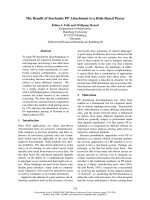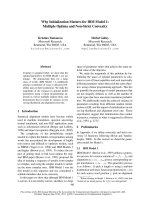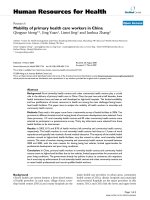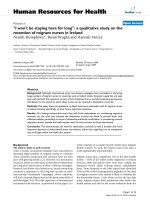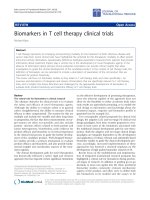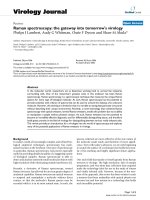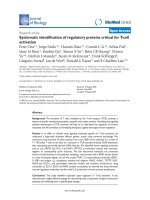Báo cáo sinh học: " Why didn’t Darwin discover Mendel’s laws" pdf
Bạn đang xem bản rút gọn của tài liệu. Xem và tải ngay bản đầy đủ của tài liệu tại đây (2.07 MB, 8 trang )
Opinion
WWhhyy ddiiddnn’’tt DDaarrwwiinn ddiissccoovveerr MMeennddeell’’ss llaawwss??
Jonathan C Howard
Address: Institute for Genetics, University of Cologne, Zülpicher Strasse 47, 50674 Cologne, Germany. Email:
Heredity and variation were two concepts that played a
central role in Darwin’s development of the theory of
evolution by natural selection. The enormous effort he
devoted to their analysis is reflected not only in the entire
two-volume The Variation of Animals and Plants under
Domestication [1], but also in countless experiments and
observations narrated elsewhere. Yet despite a lifetime’s
efforts, he never came close to understanding the logic of
inheritance, while his views on the nature and causation of
variation oscillated back and forth between a concept of
random, quasi-physical events outside environmental control,
which indeed looks decidedly modern, and a concept,
evidently owing much to his predecessors, of environ-
mentally driven adaptive change transmitted to the germ
cells. Here, I ask why Darwin failed, even after so much
effort, to reach a correct position on these critical problems.
The solution, at least to the inheritance problem, was
apparently easily amenable to an experimental approach
with materials that were daily to hand. Furthermore the
time was ripe in the middle of the 19th century, with many
breeders interested in the problem for commercial as well as
scientific reasons. And after all, Mendel (Figure 1) solved
the logic of inheritance in his own backyard in the
monastery at Brno [2] with no more technology than
Darwin had at his disposal in his garden at Down House.
Why couldn’t Darwin have done it too?
There is a plausible answer to this question that has a very
long reach, far into the 20th century, namely Darwin’s
commitment to quantitative variation as the raw material of
evolution. There were surely also other contributing issues
that turned him away from the kind of investigations that
would have led him to the answer. One was that inheritance
as such was really not a controversial issue. Even though he
needed inheritance as a key player in the theory of
evolution by natural selection (“Any variation which is not
inherited is unimportant for us” [3] p12) he could appeal to
the general belief system, which upheld the constancy of
species, while at a more professional level he asserted “No
breeder doubts how strong is the tendency to inheritance:
that like produces like is his fundamental belief” ([3] p12)
and he summarizes his position with “perhaps the correct
way of viewing the whole subject would be, to look at the
inheritance of whatever character as the rule, and non-
inheritance as the anomaly” ([3] p13). Thus, in a sense, the
heritability of a character could be treated as a given for the
purposes of the general exposition of the theory of
evolution by natural selection.
PPiiggeeoonnss aanndd ssnnaappddrraaggoonnss
Since the rediscovery of Mendel we have become used to
the principle of working with unit factors of qualitative
effect as if they represented explicit, patent instances of the
kinds of variation that have evolutionary implications. Now
that every variation, whether of large or small effect, can be
followed by simple Mendelian genetics using the under-
lying sequence changes, the difference between ‘qualitative’
AAbbssttrraacctt
Darwin’s focus on small quantitative variations as the raw material of evolution may have
prevented him from discovering the laws of inheritance.
Journal of Biology
2009,
88::
15
Published: 24 February 2009
Journal of Biology
2009,
88::
15 (doi:10.1186/jbiol123)
The electronic version of this article is the complete one and can be
found online at />© 2009 BioMed Central Ltd
and ‘quantitative’ characters has been lost for many pur-
poses. Darwin was ambivalent about visible, discontinuous
variations. They displayed the phenomena of inheritance in
an immediately appreciable form, but under the conditions
in which, until Mendel, such variation was studied, even the
behavior of apparently ‘unit’ characters through the
generations was too obscure to make sense. In particular,
many of the variations that attracted Darwin’s interest had
been accumulated through horticultural or agricultural
selective breeding and were recessive to the wild type. From
Darwin’s standpoint the loss of recessive phenotypes in test
crosses and, even more striking, the recovery of the wild
type in crosses between non-allelic recessives, had polemical
value in enabling wild ancestry to be claimed even for the
phenotypically extreme products of selective breeding
(Figure 2). Those who supported the fixity of species were
skeptical that fancy pigeons with radically distinct pheno-
types could have been derived from a single wild ancestral
species. Yet Darwin could win the argument dramatically by
crossing two such fancy strains and generating progeny with
a perfect wild rock dove phenotype. Furthermore, in the
absence of pure lines distinguished by single unit characters,
the simple behavior of the F1 hybrid between two different
phenotypes was often confused by the behavior of
subsequent generations, in which multiple polymorphic
systems read out onto the complex character of interest
(Figure 3). Despite the polemical value of some aspects of
discontinuous character inheritance, therefore, Darwin’s
conclusion from his studies on inheritance was always the
same, that the rules and mechanisms of inheritance were
complex and not ready for a definitive analysis.
Mendel’s extraordinary insight into the simplifications
necessary to extract sense from his breeding program would
also have been necessary for Darwin were he to have taken
up the challenge seriously. We can discount almost
everything that Darwin did or said about inheritance
because he lacked Mendel’s insight and failed to recognize
what was wrong with his material. But we cannot discount
it all. In his pursuit of a better understanding of the
importance of cross-breeding for evolution he reported
many instances in which heritable unit characters showed
what to our eyes can be understood as Mendelian behavior.
In one especially poignant case [1], working with the
recessive character of radially symmetrical (peloric) flowers
of Antirrhinum (Figure 4), Darwin came close to the kind of
result that might have ended with a law of segregation. He
crossed pure-breeding peloric plants with pure breeding
wild types, noting the dominance of the wild type in the F1
progeny. He then established the F2 generation and
obtained wild-type and peloric plants in a ratio (88:37) that
Mendel (and now we) would effortlessly accept as repre-
senting 3:1. However, Darwin had other priorities and was
in no way programmed to see the critical meaning in these
numbers. He cites them within a sentence and they receive
no further comment.
What, if it wasn’t genetics, was Darwin doing in his study
The Effects of Cross and Self-Fertilisation in the Vegetable
Kingdom [4]? His overriding purpose was to establish that
progeny produced by self-fertilization are less thrifty than
the products of cross-fertilization. He rightly concentrated
his analysis not on unit characters, but on the quantitative
characters that fitted better with his concept of differential
fitness, the attributes that, by their infinitesimal differences,
determine life and death in the wild. So Darwin counted
seeds, weighed and measured them, planted them and
looked for their vitality. He measured growth and general
thriftiness in his self-fertilized and cross-fertilized progeny.
Everything he measured was a quantitative variable that
under these simple experimental conditions could yield no
information about inheritance at all. His experiments are
overwhelming in scale and scope; they established the point
that he wanted to establish beyond all doubt, but they
contributed nothing relevant to our understanding of the
underlying logic of inheritance.
15.2
Journal of Biology
2009, Volume 8, Article 15 Howard />Journal of Biology
2009,
88::
15
FFiigguurree 11
Gregor Mendel: a commemorative stamp issued by the Free City of
Danzig in 1939. The texts above the picture read “Healthy children”
and “Happy future”.
TThhee ffoorrmmss ooff fflloowweerrss
The reader who seeks Mendelian impulses in Darwin’s work
will be disappointed with the yield of such insights in Cross
and Self-Fertilisations and turn to The Different Forms of
Flowers on Plants of the Same Species [5]. Here Darwin wrote
an entire book on a perfect Mendelian character showing
unambiguous phenotypes and numerically precise and
well-established behavior, yet he failed to extract Mendelian
insights from his work. The Different Forms of Flowers is
devoted to various cases of heterostyly, the best known
being the beautiful floral dimorphisms of various species of
Primula (Figure 5). It was well known, and confirmed in
Darwin’s studies, that crosses between individuals each
bearing flowers of one of the two floral types were fertile
and generated the two floral types in the progeny equally.
Modern Mendelians can recognize the character of such a
result as a form of back-cross between a heterozygote
bearing one dominant allele and one recessive and a
homozygote bearing two recessive alleles at the locus, the
same inheritance pattern as in many sex-determination
systems. And indeed Darwin was exploring these pheno-
mena precisely because he recognized that these di- (and
elsewhere tri-)morphic floral systems were dedicated to the
enforcement of cross-fertilization.
The floral dimorphism of Primula is determined by a
complex locus encoding three closely linked genes that
determine the floral type. In elementary inheritance studies
this ‘supergene’ segregates as a single locus. Unlike the case
with our own XY sex-determination system, which behaves
genetically in a similar way, the two floral forms of Primula
possess both male and female organs and are not absolutely
self-sterile. Thus it is possible to dissect the underlying
genetics (at least at the level of the complex locus) by
examining the floral morphology of, albeit rare, progeny
from a successful self-cross. But Darwin barely did this. His
mission was accomplished by documenting the degree of
self-sterility measured by seed number and weight. He
planted the seeds of self-fertilized plants and measured their
own thriftiness by quantitative analysis, but his reports on
the floral morphology of the self-fertilized progeny are
sketchy. However, he did show that the ‘pin’ (homozygous
recessive) form breeds true whereas the heterozygous
‘thrum’ form has both thrum and pin forms in the progeny,
with an apparent excess of thrums, results consistent with
the now-known genetics of the system. Darwin summarized
his own results on the inheritance of floral morphology in
illegitimate crosses in a table, and cited data, not his own,
on illegitimate thrum crosses in Primula auricula with the
statement shown in Figure 6, a remarkable statement given
that it appears to be a numerical approximation to a
Mendelian ratio. It would be interesting to find out from
what source these data came: it is probably already known
and I should be glad to learn. In a letter to Alfred Russel
Wallace in 1866 [6] Darwin also drew attention to the
generation of both unblended parental forms “even out of
the same pod” in crosses between two varieties of sweet pea,
presumably among an F2 progeny, but he did not comment
on the relative yields. He did, however, see a similarity
between this kind of genetic behaviour and sex determination
when he added that the former were not more wonderful
/>Journal of Biology
2009, Volume 8, Article 15 Howard 15.3
Journal of Biology
2009,
88::
15
FFiigguurree 22
Reversion to the ancestral type. Two non-allelic, recessive white
mutants in domestic fowl (top) complement each other to generate
perfect wild-type male (bottom right) and female (bottom left) progeny.
Reversion was of polemical value for Darwin in indicating that highly
divergent domesticated stocks had been derived from a single ancestral
species, but contributed to the widespread confusion over the laws of
inheritance. From [16] plate 4 between pages 100 and 101.
“than every female in the world producing distinct male &
female offspring”.”
IInnffiinniitteessiimmaallss
Obviously Darwin was not on the right wavelength to be
able to use inheritance data from crosses involving unit
characters. Why not? The material was there and the
problem of inheritance was patently unsolved and important.
Much has been written, and with justice, of Mendel’s
extraordinary preadaptation to solving the problem he so
precisely set himself: his mathematical bent, and his
education in biology, physics, statistics and probability
theory [7] that was far superior to anything Darwin could
have got in a British university. Even if Darwin had decided
to press on with his Antirrhinum or Primula studies he
15.4
Journal of Biology
2009, Volume 8, Article 15 Howard />Journal of Biology
2009,
88::
15
FFiigguurree 33
Fragmentation of a qualitative character in
Primula sinensis
. The F1 (3) of a cross between the two parental varieties (1 and 2) is constant and
somewhat intermediate in character, although white. The F2 progeny (bottom three rows) are highly variegated, atomizing the overall phenotypic
difference between the two parents into a remarkable number of distinct traits. Phenomena like this bedeviled the efforts of many breeders, until
Mendel, to find simple laws of inheritance. From [16] plate 7 between pages 298 and 299.
12
33
16 17 18 19 20 21
perhaps would not have seen through the stochasticity of
the experimental results to the whole numbers that were
waiting to be discovered. The explanation, though, for why
Darwin turned away from the inheritance of unit characters
as a possible route to resolving the general inheritance
problem was simply that he did not believe that such
characters had anything to do with the kind of variations
that he thought were the raw materials of evolutionary
change. Such qualitative and striking variations he charac-
terized as ‘sports’. They might be useful for the breeders of
fancy plants and animals, but although artificial selection of
such anomalous variants could provide an analogy to
evolution by natural selection, this was not the real thing.
Again and again, when Darwin wrote generally about
evolution, he came back to one issue, the infinitely tiny
differences between individuals that confer infinitesimal
advantages or disadvantages in the interminable struggle for
existence. The selection of these variants, continued over
hundreds of thousands of generations, was the critical
process in evolution. These were the variations, and this was
the inheritance, that mattered. This view of biology was
uniquely Darwin’s and one he took over wholesale from
Charles Lyell’s uniformitarian geology during and after the
Beagle voyage. Indeed this was by far the strongest, most
important, and heuristically most productive of all the
influences Darwin was subject to (“I always feel as if my
books came half out of Lyell’s brain” [8]). Uniformity of
small actions over long time gave Darwin much of his
geology and above all his exquisite theory of coral reefs. It
also gave him evolution.
Darwin’s commitment to the finest possible grain of
quantitative variation is so explicit in his writing that it is
impossible to doubt its importance for him. One can find
dozens of passages like the last sentence of Darwin’s early
sketch [9]: “There is a simple grandeur in this view of life…
having been breathed into matter under a few forms,
perhaps only one,… and that from so simple an origin,
through the selection of infinitesimal varieties, endless forms
most beautiful and most wonderful have been evolved”, or
“If selection consisted merely in separating some very
distinct variety, and breeding from it, the principle would be
so obvious as hardly to be worth notice; but its importance
consists in the great effect produced by the accumulation in
one direction, during successive generations, of differences
absolutely inappreciable to the uneducated eye - differences
which I for one have vainly attempted to appreciate” ([3]
p32), or “It may be said that natural selection is daily and
hourly scrutinising, throughout the world, every variation,
even the slightest: rejecting that which is bad, preserving and
adding up all that is good” ([3] p84), or, lastly, “Natural
selection can act only by the preservation and accumulation
of infinitesimally small inherited modifications, each
profitable to the preserved being; and as modern geology has
almost banished such views as the excavation of a great
valley by a single diluvial wave, so will natural selection, if it
be a true principle, banish belief in the continued creation of
new organic beings, or of any great and sudden modification
in their structure.” ([3] p95).
Quantitative variation, then, was at the heart of Darwin’s
evolution, and quantitative variation is the last place where
clean Mendelian inheritance can be seen, Look at the
difficulties! All quantitative variation is determined by
multiple allelic systems of small effect. Furthermore,
quantitative variation shows the greatest sensitivity to
environmental variables. Finally, many characters that show
complex quantitative inheritance are also subject to
genetically determined adaptability, such as skin color or
muscle mass. This last was indeed Darwin’s undoing when
he attempted to construct a general theory of variation and
inheritance, the ‘Provisional Hypothesis of Pangenesis’ ([1],
Chapter XXVII). It was responsible for his persistent belief
in the inheritance of acquired characters and determined
much of the design of the pangenesis theory.
PPaannggeenneessiiss
When he embarked on the ‘Provisional Hypothesis of
Pangenesis’ [1] it was the behavior of continuously variable
characters that Darwin set out to account for. This widely
unloved hypothesis was a great favorite of Darwin’s and the
only time when he ventured into the domains we would
/>Journal of Biology
2009, Volume 8, Article 15 Howard 15.5
Journal of Biology
2009,
88::
15
FFiigguurree 44
Wild-type and peloric flowers of
Antirrhinum majus
. Darwin noted the
near-complete dominance of the wild type and the segregation of the
recessive allele in the F2. This is a floral trait determined by a single
recessive allele and could have given Darwin the Mendelian ratios if he
had pursued his breeding experiments. Photograph kindly provided by
and copyright Enrico Coen. Reproduced with permission.
Wild type X Peloric
now call cell biology and biochemistry. Hampered already
by his focus on quantitative variation and, like most British
biologists, unconvinced by the contemporary German
triumph of cell theory, Darwin was in no position to get it
right. He conceived of tiny self-replicating determinants
representing all characters at the finest possible level of
discrimination. If an organ looks thus, so its pangenetic
representation will be such as to determine such an
appearance. If an organ is large, small, long, or short, each
characteristic parameter can be measured by the number of
pangenes that determine it. Inheritance of such a character
follows from the collection, according to exact proportional
representation, of all possible pangenes from all parts of the
body into the germ cells; a heavier muscle, then more
pangenes for each relevant component, and a higher
representation of each in the germ cells. Every aspect of
phenotype was covered by appropriate pangenes, even the
left and right halves of the body were separately determined.
Much of Darwin’s representation of the pangenesis
hypothesis concerns measurable quantitative characters,
such as muscle mass, for which it was straightforward to
relate variations in some parameter, such as size or weight,
with the number of the relevant pangenes. Obsessed as he
was by the infinitesimal character of variation, Darwin took
a lot of trouble to convince his readers that pangenes were
so extremely small that all necessary pangenes would fit
into the critical smallest compartment, namely the germ
cells. Even here, Darwin was far less confident than Mendel
that one sperm and one egg constituted the essential
minimum. Nevertheless, supported by a calculation from
his mathematically gifted son George, Darwin convinced
himself that molecular sizes were tiny enough for him to
pack all the pangenes he needed into the compass of a
single fertilized egg or sperm.
One can follow the internal logic of pangenesis and see that
it is preadapted to be a theory of continuous, not discon-
tinuous, variation. Saddled with his infinitesimal variations,
Darwin was driven by the pangenesis theory in a direction
he never seems to have been totally averse from, namely the
inheritance of acquired characters. If the adaptability of the
soma generated adaptive change, as the blacksmith’s muscles,
so more muscle pangenes were needed to account for the
extra muscles and would consequently be overrepresented
in the germ cells. Darwin’s view of inherited variation was
complex, and the inheritance of acquired characters was
only one strand in an unresolved tangle of ideas. But it
dominates the pangenesis hypothesis and one may suppose
that Darwin’s (largely unshared) affection for his own
hypothesis was responsible for a trend, noted by many
commentators, towards favoring the significance of this
15.6
Journal of Biology
2009, Volume 8, Article 15 Howard />Journal of Biology
2009,
88::
15
FFiigguurree 55
Drawings taken from Darwin’s
The Different Forms of Flowers on Plants of the Same Species
[5], illustrating the clear morphological distinction
between the two floral types of
Primula
flowers. The ‘thrum’ (short-styled) form is determined by a dominant ‘supergene’ in the heterozygous state,
the ‘pin’ (long-styled) form by the homozygous recessive. Thrum and pin forms are maintained in roughly equal numbers by the high fertility of thrum
x pin crosses and near infertility of the two illegitimate thrum x thrum and pin x pin crosses. Although Darwin worked extensively on this beautiful
qualitative trait, his interest was focused on the quantitative deficit of illegitimate progeny rather than the genetic control of the trait itself.
kind of evolutionary change in the later editions of On the
Origin of Species. Unlike the great bulk of Darwin’s original
ideas, pangenesis, published in 1868 [1], is a latecomer, not
foreshadowed in his earlier notebooks and essays.
FFrroomm GGaallttoonn aanndd BBaatteessoonn ttoo GGoouulldd
Darwin is occasionally criticized as an imprecise, non-
numeric naturalist, a man of ideas, perhaps brilliant and
original in that mode, but not a scientist like those of
today. Indeed I am sure I have heard this view from
eminent members of my own institute. Mendel’s
rational, experimental analysis of the inheritance of unit
characters is without question a work of great genius.
One reads it still with the same sense of breathless
excitement, of irresistible intellectual force and forward
propulsion that one experiences, for example, from the
extraordinary Nature paper by Crick, Brenner, Barnett
and Watts-Tobin on the encoding of proteins [10].
However, if Darwin failed to discover Mendel’s laws, it
was not so much because of what he lacked in genius or
numeracy or the experimental cast of mind, but rather
because of the forceful tendency of what he already
possessed. His focus on continuous variation as the
source of evolutionary change was not wrong, and
coupled with the power he could see in the integration
of infinitesimals over time he built his case on the solid
foundation of Lyell’s uniformitarian thinking. Much of
variation and inheritance was simply opaque in those
terms, but continuous variation, not unit characters,
was, for Darwin, the way forward. Thus Darwin boxed
himself in, unable to see the laws of inheritance in
continuous variation, unable to see the real importance
of discontinuous variation where the laws of inheritance
could be discerned.
The scientist in the best position to resolve Darwin’s
problems was his own cousin, Francis Galton (Figure 7).
While Darwin was wrestling with pangenesis Galton was
pioneering the analysis of the inheritance of quantitative
characters and he documented with extraordinary
insight the properties of such inheritance. In particular,
he documented the phenomenon of regression to the
mean in the context of the inheritance of quantitative
characters such as height or intelligence. Regression to
the mean records the interaction between control of the
character by multiple polymorphic loci of small effect
and, of course, multiple environmental effects. Galton
approached a correct genetic interpretation of this
phenomenon while Darwin confused it with blending
inheritance. He also took a lively interest in pangenesis
(which he eventually rejected, to Darwin’s chagrin) and
corresponded extensively with Darwin about it. In a
somewhat gnomic response to a query from Darwin,
Galton replied “If there were two gemmules only, each
of which might be white or black, then in a large
number of cases one-quarter would always be quite
white, one-quarter quite black, and one half would be
grey”. Such is indeed the stuff of continuous variation
seen from a Mendelian perspective, but perhaps Galton
was too distant from the biology of inheritance and too
interested in the mathematics of what he was
discovering to take his own suggestion to its most
important conclusion.
Galton died in 1911, a full decade after the multiple
republications of Mendel’s paper and multiple reiterations
of his findings by other authors. It is surprising that Galton
in his old age did not take the opportunity, which he of all
geneticists of that era was qualified to take, to reconcile the
Mendelian laws of inheritance with Darwin’s (and his own)
priority for continuous variation as the fuel of evolutionary
change. In the event, most of Galton’s contemporaries largely
abandoned Darwin’s view in favor of mutations of large
effect as the driving force for evolutionary change. William
Bateson, in his 1894 Materials for the Study of Variation [11],
had already backed large-scale discontinuous variation as
the basis for evolution and the origin of species, “for if
distinct and ‘perfect’ varieties may come into existence
/>Journal of Biology
2009, Volume 8, Article 15 Howard 15.7
Journal of Biology
2009,
88::
15
FFiigguurree 66
Darwin’s table summarizing the results of
Primula
crosses. Note
especially the last line referring to the
Primula auricula
data, where the
recessive and dominant forms respectively are cited as occurring in a
1:3 ratio in crosses between heterozygous dominant (short-styled)
individuals. Reproduced from [5].
discontinuously, may not the Discontinuity of Species have
had a similar origin? If we accept the postulate of Common
Descent this expectation is hard to resist. In accepting that
postulate it was admitted that the definiteness and
Discontinuity of Species depends upon the greater
permanence of certain terms in the series of Descent. The
evidence of Variation suggests that this greater stability
depends primarily not on a relation between organism and
environment, not, that is to say, on Adaptation, but on the
Discontinuity of Variation. It suggests, in brief, that the
Discontinuity of Species results from the Discontinuity of
Variation.” Elsewhere, the sneering tone of Bateson’s conclu-
ding remarks on adherents of the Darwinian view suggests
the ill-humor that accompanied this debate right through
until the late 1920s, when Fisher, Haldane, Sewall Wright
and others reconciled Mendelism with continuous variation
(reviewed in [12]). Hugo de Vries, whose own studies of
discontinuous variation led him to the rediscovery of
Mendel, also argued [13] for variation of large effect as the
driving force in evolution, and even as late as the 1930s this
strand of thought was still prominent in Richard
Goldschmidt’s ‘hopeful monsters’ [14]. The old dichotomy
between continuous and discontinuous variation as the
engines of evolution surfaced again in a slightly different
form in our own generation through the polemic of Niles
Eldredge and Stephen J Gould for evolution by punctuated
equilibrium [15]. No doubt we shall see it again.
AAcckknnoowwlleeddggeemmeennttss
I thank Christiane Nüsslein-Volhard (Max Planck Institute for Develop-
mental Biology, Tübingen) for encouragement to write this piece, Enrico
Coen (John Innes Centre, Norwich) for the picture of the wild-type and
peloric
Antirrhinum
flowers, and Thiago Carvalho (Gulbenkian Institute
of Science, Lisbon) for drawing my attention to the Darwin letter cited
as reference [6].
RReeffeerreenncceess
1. Darwin CR:
The Variation of Animals and Plants under Domestica-
tion. Volume 2.
London: John Murray; 1868.
2. Mendel G:
VVeerrssuucchhee üübbeerr PPffllaannzzeenn HHyybbrriiddeenn
In
Verhandlungen
des naturforschenden Vereines in Brünn
1865,
IIVV::
3-47. Brünn: Im
Verlage des Vereines, 1866.
3. Darwin CR:
On the Origin of Species by Means of Natural Selec-
tion.
London: John Murray; 1859.
4. Darwin CR:
The Effects of Cross and Self-Fertilisation in the Veg-
etable Kingdom.
London: John Murray; 1876.
5. Darwin CR:
The Different Forms of Flowers on Plants of the Same
Species.
London: John Murray; 1877.
6. Darwin Correspondence Project [ />darwinletters/calendar/entry-4989.html]
7. Orel V:
Gregor Mendel, the First Geneticist.
Oxford: Oxford Uni-
versity Press; 1996.
8. Darwin F, Seward AC:
More Letters of Charles Darwin.
New
York: D. Appleton; 1903.
9. Darwin CR:
Charles Darwin’s Essay of 1844.
Edited by de Beer G.
Cambridge: Cambridge University Press; 1958.
10. Crick FH, Barnett L, Brenner S, Watts-Tobin RJ:
GGeenneerraall nnaattuurree ooff
tthhee ggeenneettiicc ccooddee ffoorr pprrootteeiinnss
Nature
1961,
119922::
1227-1232.
11. Bateson W:
Materials for the Study of Variation.
London: Macmil-
lan; 1894.
12. Huxley JS:
Evolution, the Modern Synthesis
. London: George Allen
and Unwin; 1942.
13. De Vries H:
Die Mutationstheorie.
Leipzig: Veit; 1901-1903.
14. Goldschmidt RB:
The Material Basis of Evolution.
New Haven:
Yale University Press; 1940.
15. Eldredge N, Gould SJ:
PPuunnccttuuaatteedd eeqquuiilliibbrriiaa:: aann aalltteerrnnaattiivvee ttoo
pphhyylleettiicc ggrraadduuaalliissmm
. In
Models in Paleobiology
. T.J.M. Schopf
edition. San Francisco: Freeman, Cooper and Company; 1972:82-
115.
16. Bateson W:
Mendels Vererbungstheorien
. Leipzig and Berlin: B.G.
Teubner; 1914.
17. Pearson K:
The Life, Letters and Labours of Francis Galton.
Volume 2.
London: Cambridge University Press; 1924.
15.8
Journal of Biology
2009, Volume 8, Article 15 Howard />Journal of Biology
2009,
88::
15
FFiigguurree 77
Francis Galton, the anthropometrician, in 1893. Reproduced from an
anthropometric study cited in [17].
